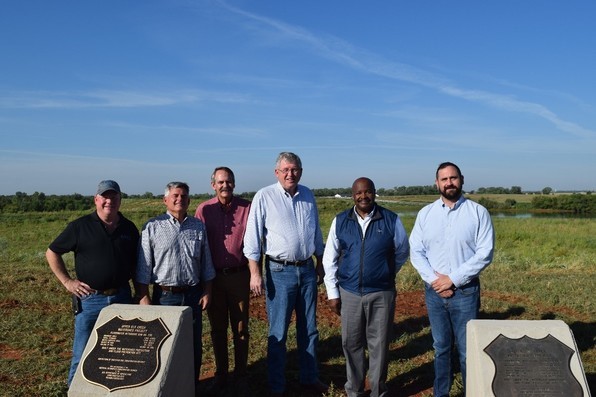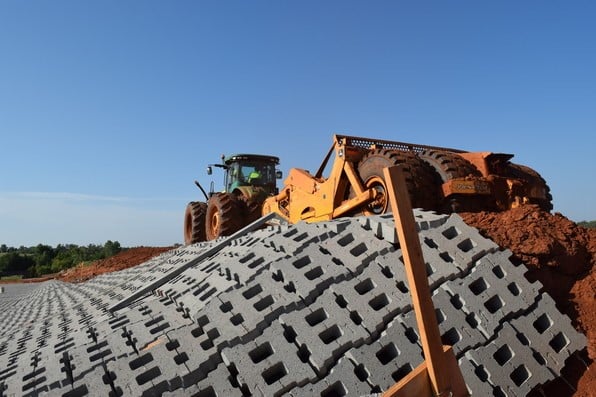Re-dedication of Upper Elk Creek Site 23D draws many leaders
Federal, state and local officials gathered Wednesday for the re-dedication of Upper Elk Creek Site 23D, an upstream flood control dam, just east of Elk City.
It was an excellent day of celebration for the many decades of protection the recently completed rehabilitated dam will bring.
U.S. Congressman Frank Lucas, Natural Resources Conservation Service Chief Terry Cosby, Oklahoma Conservation Commission Executive Director Trey Lam, NRCS State Conservationist Gary O’Neill, NRCS Oklahoma State Conservation Engineer Chris Stoner, newly elected State Representative Nick Archer and Watershed project sponsor, North Fork of Red River Conservation District were among the officials participating in the ceremony and site visit.

At the re-dedication, Lam said of Lucas, “He’s written more Farm Bills than anyone in Washington and the watershed program and conservation in western Oklahoma I know are very close to his heart and something that Dan Sebert, Executive Director of the National Watershed Coalition, and ourselves have talked to him many, many times about. And, the things that are happening here today are a result of the work Frank’s been doing all these years. And you also don’t do this without conservation partners such as NRCS, Districts such as the North Fork of Red River Conservation District and landowners such as the Thompsons.”
Congressman Lucas said, “The thing we do today is we complete a commitment to extend the life of these important structures, not just by 50 years, the initial plan, but I personally believe with the change in the materials we are using, the design technology adjustments the upstream sediment control programs that we use in many places, these structures should last a century.”
Chief Cosby said, “I will tell you that the watershed program has been near and dear to my heart for a long time. This is my 43rd year of working for USDA. Oklahoma has always been a leader in watershed programs. As a State Conservationist, we always looked at Oklahoma and wanted to be just like it because of the work that you have done here to protect the property and lives. You are first in a lot of areas, but this is one of those important things and we talk about locally-led and this is where locally-led works: Local issues, local problems and they filter up and we try how to figure out how to solve those local issues and we do that through soil and water conservation districts. It works so well with all the partners out there.”
Upper Elk Creek Site 23D
Originally constructed in 1976 at a cost of $102,401 and classified as a significant hazard dam, this is now a high hazard dam. An increase in risk of loss of life and property damage due to a potential overtopping breach of the dam during an extreme flood event is the reason site 23D has undergone this rehabilitation.
Although Site 23D was functioning as originally planned and providing downstream flood damage prevention, this rehabilitation to Site 23D now reduces the potential of a dam breach and subsequent potential damage to downstream properties and infrastructure and reduces the risk of loss of life. It now meets all current dam safety criteria.

The top of dam elevation was increased by 4.4 feet. Due to the raised top of dam elevation, the county road, N Eastern Ave., was raised as well. A new 30-inch reinforced concrete pipe was installed using techniques known as “jack and bore.” Articulated concrete blocks (ACBs) were added to the exit channel of the spillway to provide erosion protection and prevent head cutting. The contractor for the rehabilitation construction was C-P Integrated Services, Inc., of Oklahoma City. The rehabilitation construction costs were $4.25 million, with 65 percent of this cost provided by the federal government and 35 percent provided by the Conservation Commission on behalf of the watershed project sponsor, North Fork of Red River Conservation District.
Ongoing support
This project is also a great example of the incredible support that upstream flood control dams have received from Oklahoma and federal conservation leadership.
One form of support that is significant is the passage of SB 1938, authorizing the Oklahoma Capitol Improvement Authority for bond issuance in the amount of $17.5 million on behalf of the Oklahoma Conservation Commission. This received the Governor’s signature.
These funds are being used for the repair and rehabilitation of high-hazard dams pursuant to the Conservation District Act.
The 2,107 upstream flood control dams constructed in Oklahoma (The most of any state in the nation) have established a $2 billion infrastructure that provides benefits to thousands of citizens. In fact, it’s estimated that the dams and accompanying conservation practices in the watersheds provide approximately $96 million in benefits each year. Not only do they provide flood and erosion control to over two million acres of agricultural land in downstream flood plains, but they also provide sources of water for livestock and irrigation and habitats for wildlife. Specifically, 42 of the flood control dams were constructed as multi-purpose structures, which provide municipal and rural water supplies and recreation areas for local communities.
Altogether, the flood control dams provide the following benefits:
- Protecting 2,756 county and highway bridges
- Providing a reduction in flooding for 41,744 farms and ranches
- Trapping 19 million tons of sediment each year, which would otherwise end up in major streams and lakes
- Creating or enhancing 90,979 acres of wetlands
NRCS state engineer Stoner said, “As mentioned we’ve done more rehabs than any other state, this is actually the 40th completed rehab job that we’ve done in Oklahoma. That just leaves 183 yet to go, as of today.”
